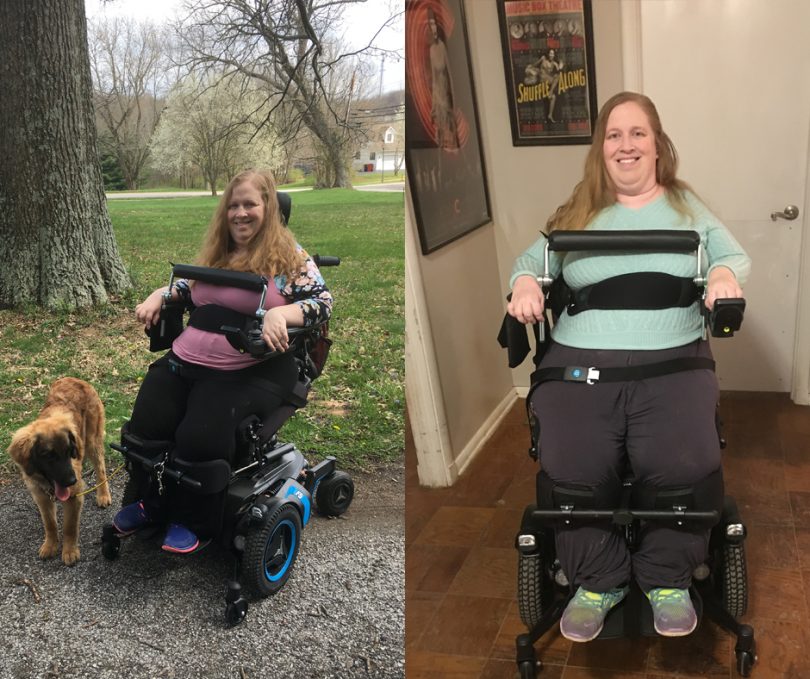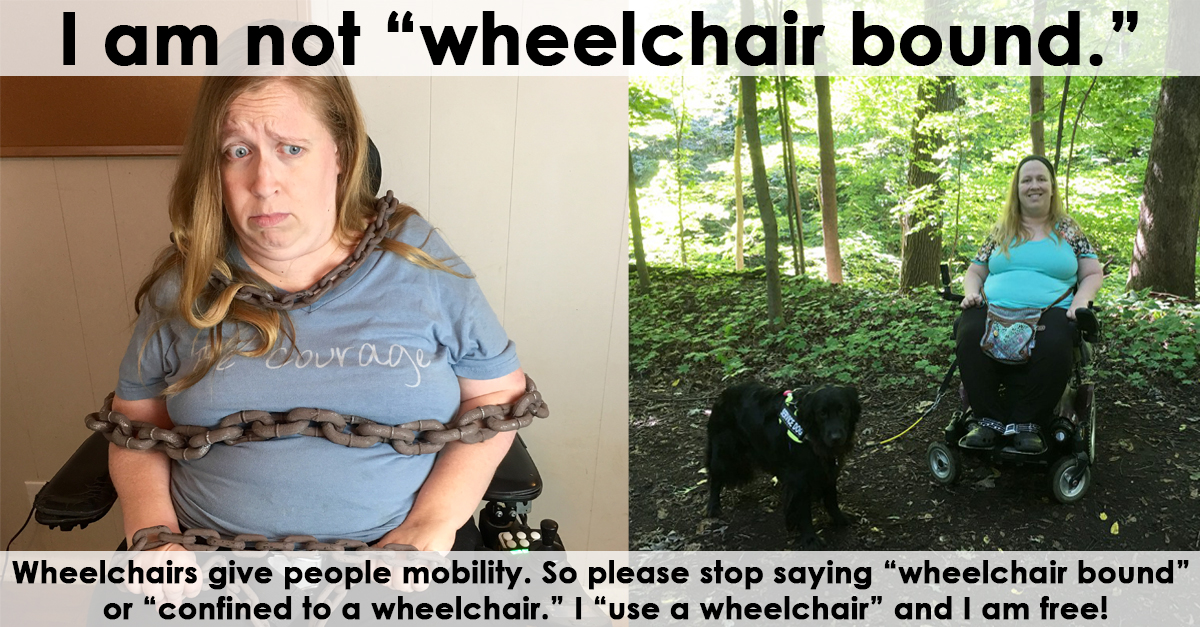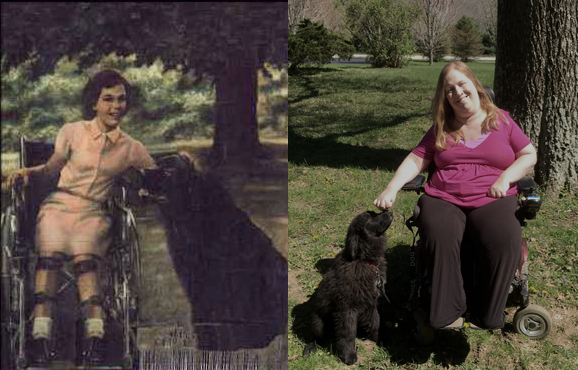A few days ago, I stood on my own two feet for the first time in 10 years. I could feel the blood flowing to my legs, my head spinning slightly from my body being in a position it wasn’t accustomed to experiencing. My lungs filled deeply with air; I could feel all my organs bursting to life, free of the constant compression of sitting. I have a new standing wheelchair, a Permobil F5 VS, and I believe it’s giving me a new lease on life. But getting it has been more than a journey… it’s been a battle, and one I almost didn’t win.
When non-disabled people see someone in a standing wheelchair, they don’t necessarily understand what it takes to get that wheelchair. They may see the rows of captain’s chairs on wheels at their local medical supply store and take a step back upon seeing the price. They may not be able to look at those wheelchairs and see how they are different from the kinds of power wheelchairs people like me need and use. That’s why I realized how important it is to share my standing wheelchair odyssey, and explain why many people struggle to get a power wheelchair with the features they need.
Getting insurance coverage for a standing wheelchair is difficult.
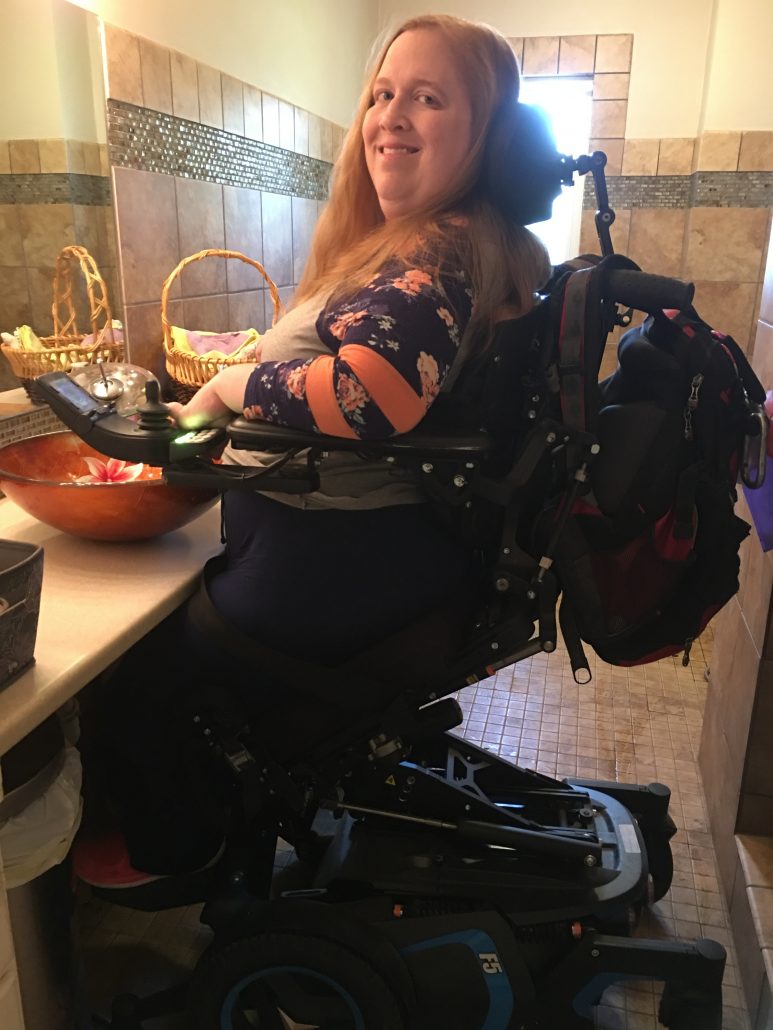
Partially standing at my sink in the Permobil F5 VS power wheelchair.
Getting insurance coverage for any kind of power wheelchair isn’t easy; you have to jump through numerous hoops. For example, to qualify for a power wheelchair under Medicare, you have to prove you can’t push a manual wheelchair, and you must need the wheelchair for use in your home. In other words, if you can walk around your house but distances or hills are too exhausting or painful, you’re out of luck. Medicare doesn’t take your word that your house is accessible, either — the mobility dealer is required to come to your home, verify it has a ramp and take measurements of your doors, even if you’ve been disabled all your life. And since your wheelchair is for use in the home, Medicare won’t pay for any upgraded functions needed to go outdoors, like bigger tires or more powerful motors. Medicare treats people with disabilities like we have no capability to live in society, regardless of our jobs, hobbies or family needs.
If you think that sounds hard, it’s nothing compared to getting funding for the kinds of wheelchairs people like me need. They are called complex rehab technology, and if you think the chairs you saw in your local medical supply store are expensive, you ain’t seen nothing yet. My wheelchair cost more than a brand new Tesla Model 3. So on the one hand, it’s understandable that insurance companies would want to make sure people actually need wheelchairs with advanced functions. On the other hand… why would you want such a wheelchair if you didn’t need it? If I could stand on my own or use a walker, I’d gladly do so. But a standing wheelchair is the only way I can be upright.
To get insurance approval for complex rehab power wheelchairs, each feature and function must be deemed medically necessary. That sounds straightforward enough, but in reality insurance companies tend to deem certain functions unnecessary no matter how much medical documentation is provided. Unfortunately, one of them is standing. Yes, despite the endless news stories about how science has proven sitting is bad for your health, insurance almost never pays for standing wheelchairs. In my case, I had a doctor’s letter and extensive documentation from a physical therapist who evaluated me, but all three of my insurances, yes three, denied the authorization request. They also denied my seat elevator, which I need to get in bed at night, reach food in my refrigerator, and wash my hands at most sinks. In insurance bean counter land, apparently sleeping, eating and hygiene aren’t medically necessary.
I could have appealed the denials, but it would’ve taken months, possibly years to fight, and I don’t know if I would have won. Thankfully I also had assistance from state vocational rehabilitation services, and they picked up the expenses insurance denied. Vocational rehabilitation was able to see how essential these functions were for me, and that’s why I have my chair today. But it’s only available to people with disabilities who are working or seeking employment.
Insurance companies can reverse their decisions after a power wheelchair is delivered, forcing people with disabilities into debt.
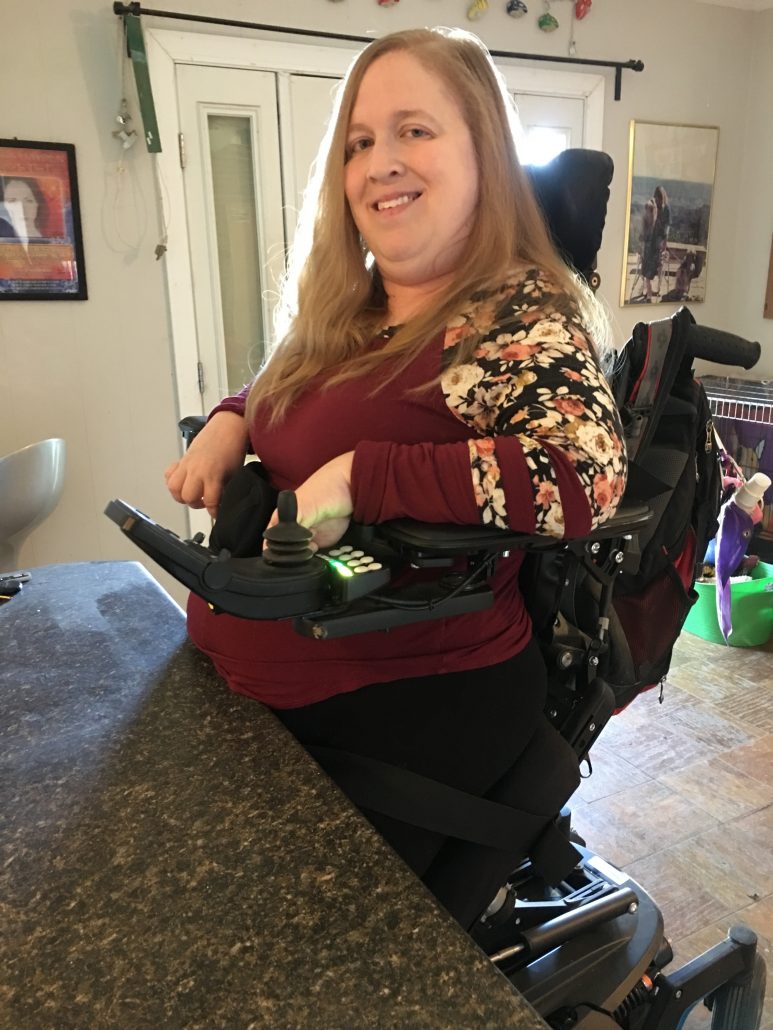
At the kitchen counter in my Permobil F5 VS standing wheelchair.
Without VR services or some other funding source, people with disabilities can find themselves in the nightmare I experienced six years ago when I got my last power wheelchair. It wasn’t a standing wheelchair, but it did have seat tilt, recline and elevation. At the time I only had private insurance, but they approved everything. Until they didn’t. A few weeks after I received that wheelchair, insurance reversed its decision and denied payment for the seat elevator. At the time I was working with a large medical equipment company in San Diego, and they said “don’t worry, we will appeal and if it’s still not approved, you won’t owe us anything.” Unfortunately I didn’t get that in writing. After the claim was denied again, they demanded payment from me for the seat elevator. It was a few thousand dollars, money I didn’t have and shouldn’t have owed. But they refused to honor their promise, and I ended up with a bad credit score because I need to move, eat and sleep.
After that horrible experience, I wanted to make sure things would go well when I pursued getting a standing wheelchair. Thankfully, the town where I’m living now has an independently owned, wonderful medical equipment dealer. They have taken the time to work with me and deal with the complex paperwork necessary for me to get this wheelchair. But even they couldn’t make the wheelchair authorization process fast or easy. It took a year. A year of wasted time on excessive paperwork, trying to dot every i and cross every t because insurance, particularly Medicare, looks for any reason possible to deny a claim. In fact, Medicare denied my entire original claim because it had been more than six months since I saw the physical therapist. Never mind that it was due to their delays; I had to see her a second time and redo the evaluation.
Insurance delays and denials harm people’s health.
A lot can change for a person with a disability over the course of a year. Cerebral palsy isn’t considered progressive, but aging and years of living with spasticity cause damage to the joints and muscles. My biggest deterioration occurred when I was trapped in an abusive relationship and could barely leave the house, causing me to gain weight and lose physical function. But the years since then, particularly since I left California, have not been kind either. We had a bad winter this year in the Midwest, and I spent much of it in debilitating pain. My left leg started swelling to the point where it became agonizingly painful; on a trip last fall, I sat with friends at a hotel struggling to have a conversation without breaking down in tears. I hate letting people see how much I hurt, because I don’t want them to feel sorry for me or expect less from me. Eventually I got a calf compression wrap which helped somewhat, but my body definitely deteriorated during that year while I waited for my wheelchair.
I believe I got this wheelchair just in time. If it had been a year later, perhaps even months later, I might not have been able to use it at all. But I have a second chance now and can rebuild some of the strength and mobility I’ve lost in the past 10 years. It’s only been a few days and I’m already stronger. Right now I’m exhausted and in pain, but it’s a different kind of pain. It makes me feel alive. It gives me hope. It tells me the fight was worth it.
“Expensive” mobility devices save money in the long run.
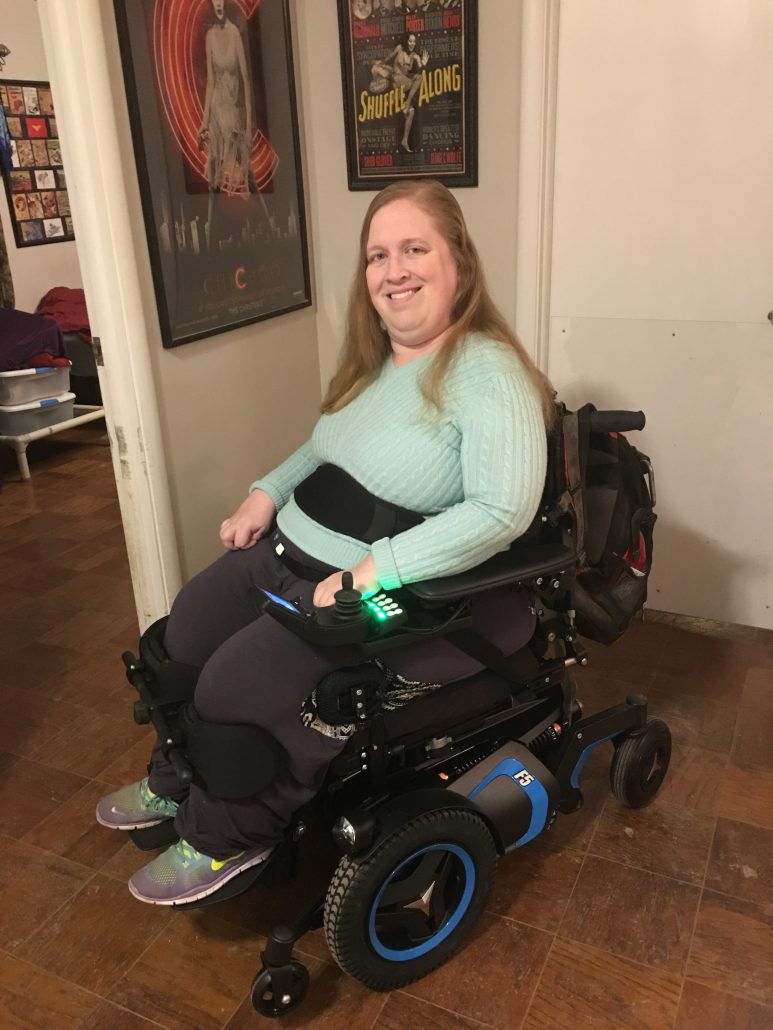
Sitting in my Permobil F5 VS power wheelchair.
I’m proud of winning the battle to get this wheelchair, but people like me shouldn’t have to fight for our basic human right to move through the world. The overwhelming nature of the process is enough to deter many who could benefit. Insurance companies consistently fail to consider the long-term cost savings of preventing illness, and this is particularly true when it comes to mobility equipment. Because of my standing wheelchair, I am less likely to be hospitalized. Preventing just one pressure sore or broken bone from osteoporosis would make paying for a standing wheelchair more than worth the cost, financially speaking. Of course not all people with physical disabilities are capable of standing, even with assistance, but shouldn’t everyone who can stand have the opportunity to do so? And this goes beyond standing — features like elevate, tilt and recline are just as medically necessary but often denied by insurance.
When considering government funded healthcare programs like Medicare and Medicaid, this benefit becomes even more pronounced. A person with a power wheelchair that is fully featured to meet their needs is more likely to be able to work, pay taxes and contribute to society through traveling, volunteering, raising children and more. People with disabilities need our wheelchairs for work, school and play to stay physically and mentally healthy — and we need them whether we can walk a little at home or can’t walk at all. The Medicare “in the home” rule for power wheelchairs also contributes to society’s skewed view of what disability means, leaving people with chronic pain and fatigue conditions thinking they’re “not disabled enough” to need a mobility device. I meet so many people with supposedly milder disabilities than mine whose lives are much more limited, and it’s often due to not having the right equipment.
Inadequate insurance coverage for power wheelchairs stifles innovation.
I’m sitting here in what is probably the most advanced power wheelchair on the market. In my opinion, Permobil is the best power wheelchair manufacturer today, especially when it comes to seating. They’ve focused on understanding body dynamics, not just how we sit but how we transition from sitting to standing, and it shows. We people with disabilities often describe our wheelchairs as part of our bodies, and the Permobil F5 VS moves with me in a way no other wheelchair ever has before. I often feel as though I’m wearing an Iron Man suit, an exoskeleton on wheels. My wheelchair is a wonder of engineering, and I love it. But looking at the big picture, there’s still so much it can’t do.
The iBot was a promising technology that collapsed due to lack of insurance funding.
In general, power wheelchairs have progressed very little since I got my first one at the age of 15. I look down at the iPhone on which I am dictating this article, and I think how can I have this amazing technology in my hand, yet wheelchairs are still stuck 20 years in the past? Why doesn’t my controller have a touch screen? Why is my house smarter than my wheelchair, and why can’t they communicate with each other, doing things like automatically adjusting lights when I roll into a room? Why is my phone powered by a tiny lithium battery while two massively heavy marine batteries sit under my wheelchair, making it virtually impossible to transport in a vehicle without a ramp or lift? Dean Kamen invented the iBot over 15 years ago; why don’t most power wheelchairs have stair climbing capabilities by now? Why do wheelchairs even still have wheels rather than robotic legs that could take us up and down stairs and over mountains? The answer is because no one will pay for these things. People with disabilities are not considered to be worth the cost.
I want to put a seat on this thing!
We have so much wonderful technology here now and coming soon, but it seems like those of us who would benefit most are often the last to have access to it. Ridesharing services. Self-driving cars. Exoskeletons. Drones and robots. These technologies are being used to spy on and kill people in wars, line the pockets of corporations and bring even more convenience to the wealthy. Why can’t companies use some of their massive profits to bring cutting-edge devices to those who need them most? Sometimes it feels like the disability community is invisible in society. That’s why I am standing up — literally — for the rights of people with disabilities and demonstrating what we can accomplish when we have the equipment we need to succeed.
Fighting for a standing wheelchair is worth it.
I realize I have painted a fairly grim picture of the process of getting a standing wheelchair, and if you need one, you may find this information disheartening. But I am not trying to deter you, only prepare you. I strongly believe if you need one of these wheelchairs, you should do whatever it takes to get one. If you believe standing would change your life, fight for your right to stand. I have fought many battles to get services and equipment over the years, and I’ve learned one thing: don’t give up. Whether intentionally or because of sheer incompetence, the system is set up to deny people with disabilities things we need. But if you’re the squeaky wheel, the persistent pest, at a certain point it becomes less hassle for them to give you what you want than continue to fight you. That’s when you win. Although many have tried, you can’t put a price on independence. So keep fighting for yours.
5,432 , 3

